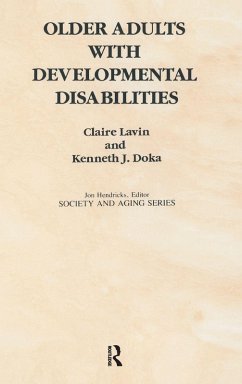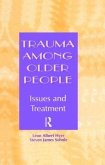- Gebundenes Buch
- Merkliste
- Auf die Merkliste
- Bewerten Bewerten
- Teilen
- Produkt teilen
- Produkterinnerung
- Produkterinnerung
Provides an overview of the elderly population who have developmental disabilities. This book attempts to assess their needs and their lives as they age. In many ways, this is a pioneer population, one of the first generations of persons with developmental disabilities who have survived into later life.
Andere Kunden interessierten sich auch für
![Counseling Older Adults Counseling Older Adults]() John BlandoCounseling Older Adults205,99 €
John BlandoCounseling Older Adults205,99 €![Counseling Older Adults Counseling Older Adults]() John BlandoCounseling Older Adults68,99 €
John BlandoCounseling Older Adults68,99 €![Psychotherapy with Older Adults Psychotherapy with Older Adults]() Bob G. KnightPsychotherapy with Older Adults148,99 €
Bob G. KnightPsychotherapy with Older Adults148,99 €![Music Therapy with Adults with Learning Disabilities Music Therapy with Adults with Learning Disabilities]() Tessa Watson (ed.)Music Therapy with Adults with Learning Disabilities49,99 €
Tessa Watson (ed.)Music Therapy with Adults with Learning Disabilities49,99 €![Trauma Among Older People Trauma Among Older People]() Leon Albert HyerTrauma Among Older People50,99 €
Leon Albert HyerTrauma Among Older People50,99 €![Trauma Among Older People Trauma Among Older People]() Leon Albert HyerTrauma Among Older People50,99 €
Leon Albert HyerTrauma Among Older People50,99 €![Working with Students with Disabilities Working with Students with Disabilities]() Theresa A. QuigneyWorking with Students with Disabilities203,99 €
Theresa A. QuigneyWorking with Students with Disabilities203,99 €-
-
-
Provides an overview of the elderly population who have developmental disabilities. This book attempts to assess their needs and their lives as they age. In many ways, this is a pioneer population, one of the first generations of persons with developmental disabilities who have survived into later life.
Produktdetails
- Produktdetails
- Verlag: Routledge
- Seitenzahl: 162
- Erscheinungstermin: 15. Juni 1999
- Englisch
- Abmessung: 235mm x 157mm x 14mm
- Gewicht: 395g
- ISBN-13: 9780895031884
- ISBN-10: 0895031884
- Artikelnr.: 54587852
- Herstellerkennzeichnung
- Libri GmbH
- Europaallee 1
- 36244 Bad Hersfeld
- gpsr@libri.de
- Verlag: Routledge
- Seitenzahl: 162
- Erscheinungstermin: 15. Juni 1999
- Englisch
- Abmessung: 235mm x 157mm x 14mm
- Gewicht: 395g
- ISBN-13: 9780895031884
- ISBN-10: 0895031884
- Artikelnr.: 54587852
- Herstellerkennzeichnung
- Libri GmbH
- Europaallee 1
- 36244 Bad Hersfeld
- gpsr@libri.de
Claire Lavin (Author) , Kenneth J Doka (Author)
Chapter I Introduction-This chapter provides a brief overview of the
issues, needs, and challenges that are presented by this new population of
older adults.
Chapter II The Emergence of the Elderly with Developmental Disabilities: A
Historical Review -This chapter further explores factors that have affected
the emergence of this cohort. Theirs is one of the first groups to move
from institutionalization to the normalization of life experiences. As they
move through the life cycle, they experience significant changes and pose a
challenge to caregivers.
Chapter III Characteristics of Older Adults with Developmental
Disabilities-A basic overview of the specific disabilities that
characterize this population is presented. The discussion includes both
impact of these disabilities on physical, social, cognitive, and
psychological development and the supports needed to help individuals
function.
Chapter IV Transitions in Later Life-As persons age, they need to cope with
numerous transitions in later life such as illness, aging, retirement,
relocation, and grief. This chapter explores these changes, and challenges
caregivers to develop ways to empower persons with developmental
disabilities to cope themselves.
Chapter V Social Life and Family Relationships-Family and friendship
relationships of older adults with developmental disabilities change over
the life cycle. This chapter explores changes that occur in later life in
housing, income, employment and religious and spiritual orientation that
impact the social lives of older adults with developmental disabilities.
Chapter VI Psychological Aspects of Aging-This chapter considers the ways
that psychological changes in cognitive and personal development affect
older adults with developmental disabilities.
Chapter VII Which System? What Services? -One of the critical issues facing
older persons with developmental disabilities is which system or network
will best provide for them. The aging network has had long experience in
assisting the elderly but scant training with persons with developmental
disabilities. On the other hand, the mental retardation/development
disabilities network historically has focused more on younger populations.
This chapter identifies service needs of the population and addresses which
are best served by each system.
Chapter VIII Public Policy and Older Adults with Developmental
Disabilities-Older adults with developmental disabilities have lived
through major policy changes which have led to their removal from
institutions and placement in the community. This chapter explores issues
facing policy makers charged with ensuring access and quality programs for
this unique population.
Chapter IX Planning Guide for Parents and Siblings-Most individuals with
developmental disabilities reside at home with aging family caregivers.
This chapter offers guidance on planning for the future of older adults to
ensure a smooth transition when family changes occur. Issues of
guardianship, letters of intent, trusts, and wills are explored to assist
families in the planning process. The chapter also includes a list of
organizations which can serve as resources in this task.
Chapter X Counseling the Older Adult with Developmental
Disabilities-Frequently the mental health needs of older adults with
developmental disabilities are overlooked. This chapter analyzes both the
mental health needs of this population and specific interventions to
address deep seated problems.
issues, needs, and challenges that are presented by this new population of
older adults.
Chapter II The Emergence of the Elderly with Developmental Disabilities: A
Historical Review -This chapter further explores factors that have affected
the emergence of this cohort. Theirs is one of the first groups to move
from institutionalization to the normalization of life experiences. As they
move through the life cycle, they experience significant changes and pose a
challenge to caregivers.
Chapter III Characteristics of Older Adults with Developmental
Disabilities-A basic overview of the specific disabilities that
characterize this population is presented. The discussion includes both
impact of these disabilities on physical, social, cognitive, and
psychological development and the supports needed to help individuals
function.
Chapter IV Transitions in Later Life-As persons age, they need to cope with
numerous transitions in later life such as illness, aging, retirement,
relocation, and grief. This chapter explores these changes, and challenges
caregivers to develop ways to empower persons with developmental
disabilities to cope themselves.
Chapter V Social Life and Family Relationships-Family and friendship
relationships of older adults with developmental disabilities change over
the life cycle. This chapter explores changes that occur in later life in
housing, income, employment and religious and spiritual orientation that
impact the social lives of older adults with developmental disabilities.
Chapter VI Psychological Aspects of Aging-This chapter considers the ways
that psychological changes in cognitive and personal development affect
older adults with developmental disabilities.
Chapter VII Which System? What Services? -One of the critical issues facing
older persons with developmental disabilities is which system or network
will best provide for them. The aging network has had long experience in
assisting the elderly but scant training with persons with developmental
disabilities. On the other hand, the mental retardation/development
disabilities network historically has focused more on younger populations.
This chapter identifies service needs of the population and addresses which
are best served by each system.
Chapter VIII Public Policy and Older Adults with Developmental
Disabilities-Older adults with developmental disabilities have lived
through major policy changes which have led to their removal from
institutions and placement in the community. This chapter explores issues
facing policy makers charged with ensuring access and quality programs for
this unique population.
Chapter IX Planning Guide for Parents and Siblings-Most individuals with
developmental disabilities reside at home with aging family caregivers.
This chapter offers guidance on planning for the future of older adults to
ensure a smooth transition when family changes occur. Issues of
guardianship, letters of intent, trusts, and wills are explored to assist
families in the planning process. The chapter also includes a list of
organizations which can serve as resources in this task.
Chapter X Counseling the Older Adult with Developmental
Disabilities-Frequently the mental health needs of older adults with
developmental disabilities are overlooked. This chapter analyzes both the
mental health needs of this population and specific interventions to
address deep seated problems.
Chapter I Introduction-This chapter provides a brief overview of the
issues, needs, and challenges that are presented by this new population of
older adults.
Chapter II The Emergence of the Elderly with Developmental Disabilities: A
Historical Review -This chapter further explores factors that have affected
the emergence of this cohort. Theirs is one of the first groups to move
from institutionalization to the normalization of life experiences. As they
move through the life cycle, they experience significant changes and pose a
challenge to caregivers.
Chapter III Characteristics of Older Adults with Developmental
Disabilities-A basic overview of the specific disabilities that
characterize this population is presented. The discussion includes both
impact of these disabilities on physical, social, cognitive, and
psychological development and the supports needed to help individuals
function.
Chapter IV Transitions in Later Life-As persons age, they need to cope with
numerous transitions in later life such as illness, aging, retirement,
relocation, and grief. This chapter explores these changes, and challenges
caregivers to develop ways to empower persons with developmental
disabilities to cope themselves.
Chapter V Social Life and Family Relationships-Family and friendship
relationships of older adults with developmental disabilities change over
the life cycle. This chapter explores changes that occur in later life in
housing, income, employment and religious and spiritual orientation that
impact the social lives of older adults with developmental disabilities.
Chapter VI Psychological Aspects of Aging-This chapter considers the ways
that psychological changes in cognitive and personal development affect
older adults with developmental disabilities.
Chapter VII Which System? What Services? -One of the critical issues facing
older persons with developmental disabilities is which system or network
will best provide for them. The aging network has had long experience in
assisting the elderly but scant training with persons with developmental
disabilities. On the other hand, the mental retardation/development
disabilities network historically has focused more on younger populations.
This chapter identifies service needs of the population and addresses which
are best served by each system.
Chapter VIII Public Policy and Older Adults with Developmental
Disabilities-Older adults with developmental disabilities have lived
through major policy changes which have led to their removal from
institutions and placement in the community. This chapter explores issues
facing policy makers charged with ensuring access and quality programs for
this unique population.
Chapter IX Planning Guide for Parents and Siblings-Most individuals with
developmental disabilities reside at home with aging family caregivers.
This chapter offers guidance on planning for the future of older adults to
ensure a smooth transition when family changes occur. Issues of
guardianship, letters of intent, trusts, and wills are explored to assist
families in the planning process. The chapter also includes a list of
organizations which can serve as resources in this task.
Chapter X Counseling the Older Adult with Developmental
Disabilities-Frequently the mental health needs of older adults with
developmental disabilities are overlooked. This chapter analyzes both the
mental health needs of this population and specific interventions to
address deep seated problems.
issues, needs, and challenges that are presented by this new population of
older adults.
Chapter II The Emergence of the Elderly with Developmental Disabilities: A
Historical Review -This chapter further explores factors that have affected
the emergence of this cohort. Theirs is one of the first groups to move
from institutionalization to the normalization of life experiences. As they
move through the life cycle, they experience significant changes and pose a
challenge to caregivers.
Chapter III Characteristics of Older Adults with Developmental
Disabilities-A basic overview of the specific disabilities that
characterize this population is presented. The discussion includes both
impact of these disabilities on physical, social, cognitive, and
psychological development and the supports needed to help individuals
function.
Chapter IV Transitions in Later Life-As persons age, they need to cope with
numerous transitions in later life such as illness, aging, retirement,
relocation, and grief. This chapter explores these changes, and challenges
caregivers to develop ways to empower persons with developmental
disabilities to cope themselves.
Chapter V Social Life and Family Relationships-Family and friendship
relationships of older adults with developmental disabilities change over
the life cycle. This chapter explores changes that occur in later life in
housing, income, employment and religious and spiritual orientation that
impact the social lives of older adults with developmental disabilities.
Chapter VI Psychological Aspects of Aging-This chapter considers the ways
that psychological changes in cognitive and personal development affect
older adults with developmental disabilities.
Chapter VII Which System? What Services? -One of the critical issues facing
older persons with developmental disabilities is which system or network
will best provide for them. The aging network has had long experience in
assisting the elderly but scant training with persons with developmental
disabilities. On the other hand, the mental retardation/development
disabilities network historically has focused more on younger populations.
This chapter identifies service needs of the population and addresses which
are best served by each system.
Chapter VIII Public Policy and Older Adults with Developmental
Disabilities-Older adults with developmental disabilities have lived
through major policy changes which have led to their removal from
institutions and placement in the community. This chapter explores issues
facing policy makers charged with ensuring access and quality programs for
this unique population.
Chapter IX Planning Guide for Parents and Siblings-Most individuals with
developmental disabilities reside at home with aging family caregivers.
This chapter offers guidance on planning for the future of older adults to
ensure a smooth transition when family changes occur. Issues of
guardianship, letters of intent, trusts, and wills are explored to assist
families in the planning process. The chapter also includes a list of
organizations which can serve as resources in this task.
Chapter X Counseling the Older Adult with Developmental
Disabilities-Frequently the mental health needs of older adults with
developmental disabilities are overlooked. This chapter analyzes both the
mental health needs of this population and specific interventions to
address deep seated problems.








